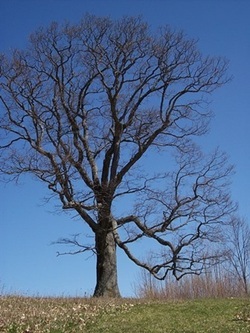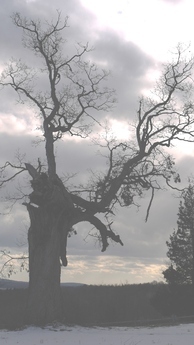
Glancing through a pile of old Arboretum newsletters, I came across a long article by Fred Lape, the Arboretum’s founder, in the Winter 1991 issue. The article is entitled “The Big Oak of the George Landis Arboretum.” Lape writes,
“The Big Oak must have been an outstanding forest tree when the land now the Arboretum was cleared, about 1840, for it was singled out by the first owner to be left standing in the open . . . .
“It was a flourishing tree until the year 1940. Then a natural disaster overtook it. That year there was an ice storm. It rained steadily and heavily day and night for three days, the rain freezing as it fell. By the end of the storm, every blade of dead grass in the fields was coated with solid ice to the thickness of a man’s thumb, and all the branchlets of trees were equally coated . . . .

“On the fourth morning the storm had ended and the sun came out. I walked over toward the Big Oak to see the damage. On the way up to its knoll one looks over a section of the woodlot that had always been the sap bush, with large maple trees that had furnished sap for maple syrup for a hundred years., There was not a single large maple left standing, only the stripped tops of trunks and the mass of fallen branches in the sun. The Big Oak lost all of its branches on the northeast side, about half of its crown.
“If I had had at the time either the money or the experience to repair the damage after the storm, the tree could probably have recovered completely, for it was then a vigorously growing tree. I had neither, and did nothing, So in a few years the open wounds left along the trunk by the pulled out bases of falling limbs, began to rot inward. Once water was able to reach beyond the growing layer of wood, the rotting inward and down accelerated, and had continued ever since. Raccoons began to nest inside the hollow trunk.”
“In the meantime, the tree has continued to grow vigorously, but during the last four years large lower branches have broken off without even a high wind or a heavy snow to cause the break, merely the weight of the branches overpowering the shallow moorings which they have in the trunk.”
I can feel the sorrow he experienced while writing these words. Certainly the frustration at his inability to repair the Big Oak motivated him to learn how to mend damage done to other trees. He ends the article wistfully:
“Even as it stands, the tree may live another hundred years, for the White Oak is a vigorous species, but the climax of its life definitely came at the end of three days of freezing rain in the winter of 1940, and from then on its way has been downward.”
Unfortunately, more extensive damaged occurred in August 2011 from Hurricane Irene, with the loss of about half of the remaining crown of the tree we now call the Great Oak. Yet what remains stands tall, a lesson on how to withstand adversity and an inspiration to us all.
